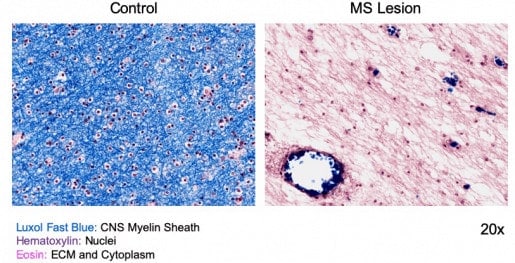Myelin, a type of glial cell, forms an insulating sheath that surrounds the nerves of the brain and the spinal cord and is critical for rapid and accurate transmission of nerve signals. Damage or loss of myelin sheath is a hallmark of several neurological diseases in adults (e.g. multiple sclerosis) and in infants (e.g. cerebral palsy) and is common after injury. However, little is known about the signaling mechanisms involved in the repair and regeneration of myelin. A recent study from Baylor College of Medicine and Texas Children’s Hospital has identified a new regulator (Nedd4) and genetic pathway (Daam2-VHL-Nedd4) that controls myelin formation during development and after injury. The study appears in the journal Genes and Development.
The study, conducted in the laboratory of Dr. Hyun Kyoung Lee, assistant professor at Baylor and investigator at the Jan and Dan Duncan Neurological Research Institute at Texas Children’s Hospital, opens up the exciting possibility of therapeutically targeting this new pathway to repair and regenerate damaged myelin after an injury or in patients suffering from myelin-associated neurological disorders. In addition, this is the first study to identify a role for Nedd4, an E3 ubiquitin ligase and for degradative machinery, the ubiquitin-proteosomal system (UPS), in regulating myelination during development and post-injury. While malfunctional degradative machinery has been associated with several neurological conditions, their role in myelination during development and repair had not been examined before.
Myelin is produced and assembled into sheaths by glial cells called oligodendrocytes (OL) via a series of steps regulated by signaling pathways. While several key features remain the same during developmental and regenerative myelination, it remains unclear how developmental programs are re-activated after an injury to initiate repair and regeneration in adulthood.
Wingless (Wnt) signaling pathway is one of the major regulators of OL development and repair in the brain. Wnt signaling is elevated in in certain brain regions (white matter) upon injury, which impairs myelin repair and regeneration by forcing the glial precursor cells to remain in a “stalled/quiescent state”. Several years back, Dr. Lee and others in the Deneen lab discovered a regulator called Dishevelled associated activator of morphogenesis 2 (Daam2) that increased Wnt activity and suppressed OL development and repair.
“Interestingly, our recent work in glial cancers led us to a new interactor of Daam2, the hypoxia-associated von Hippel-Lindau (VHL) ubiquitin ligase, a well-known tumor suppressor, whose main role is to prevent inappropriate activation of a large number of hypoxia-inducible transcription factors (HIF). We found that in glial tumors (glioma), Daam2 and VHL displayed an antagonistic relationship – Daam2 promoted the degradation of VHL, whose absence stabilized and activated the Hypoxia inducible factor (HIF), resulting in tumors. Intrigued by this finding, we wondered if Daam2-VHL displayed similar interactions in the context of myelin development and repair and this became our impetus for the current study,” Lee said.
They found Daam2 indeed suppressed VHL expression and reduced its stability, during OL development and regeneration. To identify the genetic hierarchy between these two proteins, they generated transgenic mice that lacked Daam2 only in the glial precursor cells. In the absence of Daam2, the suppression on VHL was lifted and there was excess production of mature OL, which could be reversed in mice that lacked both Daam2 and VHL. This demonstrated VHL acts downstream of Daam2 during glial development.
The ubiquitin-proteosomal system is the crucial protein degradation system found in the cells of most multicellular organisms. One of the important enzymes of the UPS are E3 ubiquitin ligases that specifically recognize the target protein and catalyze the transfer of ubiquitin molecule that marks it for further steps of degradation. To understand how Daam2 promotes the degradation of VHL, the team performed a proteomic screen to identify the candidate ubiquitin ligase(s).
After several rounds of screening and validation, they narrowed down Nedd4 as the target ubiquitin ligase. This was an exciting discovery because although Nedd4 has been implicated in early neuronal development and cancers, this was the first demonstration of its role in glial development and regeneration. Furthermore, they found overexpression of Nedd4 substantially increased ubiquitination of VHL at a specific residue, lysine 63. However, they were surprised to find that addition of ubiquitin molecules increased VHL stability, instead of promoting its degradation. Finally, they demonstrated Nedd4 is necessary and sufficient for developmental and regenerative myelination.
Consistent with this newly identified pro-myelination role for VHL and Nedd4, they saw a dramatic reduction in the levels of VHL or Nedd4 in the post-mortem brain tissues obtained from Multiple Sclerosis patients.
“Since VHL and Nedd4 are already known to play important roles in several cancers, we think down the road our findings could have broader implications that may well extend beyond myelin-associated neurological disorders or white matter injury to include malignancies,” Lee concluded.
———————————————————————————————————-
Other authors include Xiaoyun Ding, Juyeon Jo, Chih-Yen Wang, Carlo D. Cristobal, Zhongyuan Zuo, Qi Ye, Marvin Wirianto, Aaron Lindeke-Myers, Jong Min Choi, Carrie A. Mohila, Hiroshi Kawabe, Sung Yun Jung, Hugo J. Bellen, and Seung-Hee Yoo. They are affiliated to one or more of the following institutions: Baylor College of Medicine, Texas Children’s Hospital, University of Texas Health Science Center, and Max Planck Institute of Experimental Medicine. This work was supported by grants from the National Multiple Sclerosis Society (RG-1907-34551), the Hilton Foundation (#17328), National Institutes of Health (NIH)/NINDS (R01NS110859-01), the Welch Foundation (AU-1971-20180324) and NIH/NIGMS (R01GM114424).


